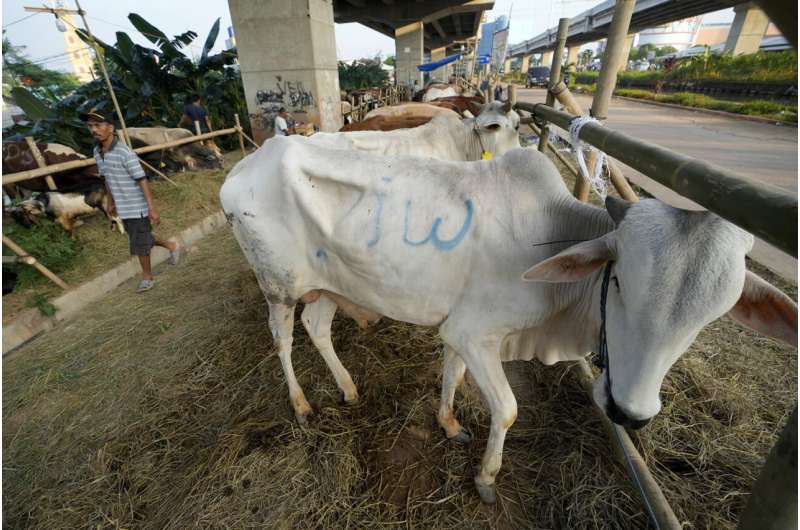A man walks past cows he sells ahead of the Eid al-Adha holiday under a flyover in Jakarta, Indonesia on July 8, 2022. Thousands of cattle are covered in blisters from highly infectious foot-and-mouth disease in Indonesia, sounding the alarm for the country, its Southeast Asian neighbors and Australia. Credit: AP Photo/Achmad Ibrahim
Thousands of cattle are covered in blisters from highly infectious foot-and-mouth disease in Indonesia, sounding the alarm for the country, its Southeast Asian neighbors and Australia. The virus found in two provinces in May has now infected several hundred-thousand animals across multiple provinces, including the popular tourist destination of Bali.
Indonesia is now taking measures to curb the spread of the disease. Australia has offered assistance in hopes of preventing the disease and its economic and environmental consequences from crossing its borders.
Here's a look at the disease and what's happening in Indonesia.
WHAT IS FOOT-AND-MOUTH DISEASE?
Foot-and-mouth disease is caused by a virus that infects cattle, sheep, goats, swine and other cloven-hoofed animals. While death rates are typically low, the disease can make animals ill with fever, decreased appetite, excessive drooling, blisters and other symptoms.
The disease was once found worldwide but has since been erased from some regions, including western Europe and North America. Parts of Southeast Asia, such as Malaysia and Thailand, have had regular outbreaks, but Indonesia until now had been free from the disease since 1986.
The ongoing outbreak is concentrated in dairy and beef cattle, but the spread to other susceptible animals can't be ruled out.
HOW DOES IT SPREAD?
The virus spreads easily through contact and airborne transmission and can quickly infect entire herds. People can spread the disease though things like farming equipment, shoes, clothing, vehicle tires and more that have come in contact with the virus. Though it's considered rare, humans can also carry the virus in their nose for short periods of time, infecting animals, said Michael Ward, chair of the Veterinary Public Health & Food Safety at the University of Sydney.
Livestock feed and animal products such as meat and hides can also carry and spread the virus.
More than 300,000 livestock in Indonesia had foot-and-mouth disease by the first week of July. In the same month, the Eid al-Adha festival—a Muslim holiday marked with ritual animal sacrifice—resulted in large movement of animals around the country, which is considered to have accelerated the spread of the disease.
WHY ARE OFFICIALS WORRIED?
Because it is so easily spread, the virus can be incredibly difficult to get rid of once there is an outbreak. In poorer countries, sick animals affect people's access to food. In middle-income and richer countries, the disease affects the livestock trade and related industries. One paper estimated that foot-and-mouth disease outbreaks can cost billions of dollars, highlighting the damage to governments and farmers.
Australia, which is currently free of foot-and-mouth disease, has expressed particular worry about the spread from Indonesia. The resort island of Bali is a popular tourist destination for Australians and has confirmed cases of the disease.
WHAT IS BEING DONE TO COMBAT THE OUTBREAK?
Indonesia is using animal testing, vaccination, treatment, and conditional slaughter to try to curb the outbreak. The Ministry of Agriculture launched a vaccination program for livestock in mid-June, prioritizing doses for healthy animals at high risk of infection, such as those at crowded places such as livestock breeding centers, community-owned dairy farms, dairy cooperatives, and beef cattle farms.
The Australian government has offered financial and vaccine assistance for Indonesia's response to the recent outbreak. The vaccination program is likely to focus on support for the small-holder farm sector, which accounts for 90% of Indonesia's cattle industry.
In Australia, the government announced it would install disinfectant mats at airports that are intended to capture potentially contaminated dirt from the shoes of those returning from overseas. Government officials also promised more stringent biosecurity checks, such as sniffing detector dogs, for those returning from overseas.
CAN PEOPLE GET FOOT-AND-MOUTH DISEASE?
No. Foot-and-mouth disease is often confused with hand, foot and mouth disease, which is caused by a different virus and mostly infects young children. People do not get the animal disease, and animals do not get the human disease, according to the U.S. Centers for Disease Control and Prevention.
© 2022 The Associated Press. All rights reserved. This material may not be published, broadcast, rewritten or redistributed without permission.






















